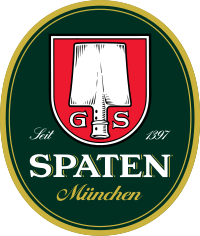Spatenbräu
Spatenbräu was a traditional brewery in Munich that traces its history back to 1397. It has been part of Spaten-Franziskaner-Bräu GmbH since 1922 , which has been part of the Spaten-Löwenbräu Group since 1997 . Today the beer brand belongs to the Belgian Anheuser-Busch-InBev brewing group.
history
The tax book of the city of Munich first mentions a brewer, Hans Welser, the Welser Prew, for the property at Neuhausergasse 4 in 1397. Over the next 125 years, the brewery's owners changed frequently until, from 1522, it was owned by the Starnberger family for exactly one hundred years. From 1622 to 1704 it was owned by the Spatt family that gave it its name, but the Sießmayr family did not change the name of the Spaten until 1807.
In 1807 the royal brewery master Gabriel Sedlmayr acquired the Spaten brewery, which was then the smallest brewery in Munich. With him, the era of the Sedlmayr family began, whose descendants are still running the company. In 1817 the Filserbräukeller in Bayerstrasse was bought, which later became the Spaten cellar.
After the death of Gabriel Sedlmayr the elder, his sons Gabriel and Joseph took over the brewery in 1839 . In 1842 Joseph Sedlmayr bought the Leistbrauerei and left the Spaten brewery as a partner. In 1851 the property was acquired on the “green meadow” with the Silberbauer cellar Marsstrasse 46-48 and expanded step by step through purchase. Three years later, the entire brewery was relocated to Marsstrasse.
Joseph Sedlmayr, owner of the Leistbrauerei, which was probably founded in the 15th century, acquired the shares of August Deiglmayr in 1861, with whom he had been running the Franziskaner brewery since 1858 .
In 1867 the Spaten brewery became the largest brewery in Munich. She was able to hold this top position until the 1890s. It was the only German brewery to receive a gold medal for its beer at the World Exhibition in Paris.
In 1874 Johann , Carl and Anton Sedlmayr took over the brewery from their father Gabriel. In 1894, Spaten was the first Munich brewery to brew Münchner Hell . It was initially intended for shipping to Northern Germany. A year later, Spaten launched the light beer in Munich, where it quickly became very popular.
The Spaten Brewery founded its own branch in London in 1891, and from 1909 Spaten beer was regularly exported to America. In 1911 Heinrich and Fritz Sedlmayr, sons of Anton and Carl Sedlmayr, respectively, joined the brewery management as partners.
In 1922 the Spaten Brewery and the Franziskaner-Leist-Bräu, both owned by the Sedlmayr family, merged to form Gabriel-und-Joseph-Sedlmayr-Spaten-Franziskaner-Leistbräu Aktiengesellschaft. In the same year a contract was signed with the Löwenbrauerei about a community of interests. In 1924 the still valid advertising slogan “Let yourself guess, drink spade” was born. Two years later the Spatenbräu Heilbier, called Vollmalz from 1941, came onto the market.
The Spaten brewery suffered severe damage as a result of bombing raids on Munich by the Allied air forces in 1943–1945, so that exports to other European countries and overseas were only possible again in 1950.
On the Oktoberfest 1964, Champagne White, the first wheat beer of the Spaten Brewery, had its premiere.
In 1992 the Spaten brewery passed the one million hectolitre mark. In 1997 the Spaten Brewery merged with the neighboring Löwenbräu to form the Spaten-Löwenbräu Group . In 2003 the group was taken over by the then Belgian brewing group Interbrew .
In the course of the following years, all of the brewery's brew kettles were gradually shut down. Since a visitor museum has been located on the brewery site of the former Spaten brewery, no more beer has been produced. Since the merger with Löwenbräu, all beers have been brewed in the former brewhouse of Löwenbräu AG. Only the bottling plant and the fermentation tanks for storing the beers remain on the site. Since then there have been no new investments. Moving the brewery to the outskirts of the city to its own new brewery is always an occasion for speculation about the location. In 2008 InBev negotiated with the Dr. Oetker belonging Radeberger Group on the sale of Spaten-Löwenbräu group. At the turn of the year 2009/10 it became known that the group, now called AB-InBev, was considering closing the brewery together with Löwenbräu. In October 2010 it was announced that the brewery had discarded the plans to move within the urban area to Langwied.
The current company logo was designed by the graphic artist Otto Hupp in 1884 . In 1821, Spaten supported the installation of what was then the only steam engine in Bavaria. The invention of the first permanently functioning refrigeration machine by Carl Linde was funded by the Spaten brewery in 1873.
literature
- Wolfgang Behringer : The Spaten Brewery 1397–1997. The history of a Munich company from the Middle Ages to the present. Piper, Munich 1997, ISBN 3-492-03600-7 .
- Ingrid Haslinger. Customer - Kaiser. The story of the former imperial and royal purveyors . Schroll, Vienna 1996, ISBN 3-85202-129-4 .
- Gabriel Sedlmayr: Spaten-Franziskaner-Bräu AG, Munich . Country Service, Brilon Westphalia / Basel 1953 (= International Industrial Library Volume 95, text in German / English / French).
- Gabriel Sedlmayr: Spaten-Franziskaner-Bräu AG, Munich: Since 1397, country service, Berlin / Basel 1963 (= International Industrial Library , Volume 164, text in German / English / French).
- Gabriel Sedlmayr, Spaten-Franziskaner-Bräu (Ed.): 600 Years of Spaten Munich: 1397–1997 . Anniversary chronicle, Spaten-Franziskaner-Bräu KGaA, Munich 1997.
- Fritz Sedlmayr: The history of the Spaten brewery and contributions to the history of the brewery 1807–1874 . Volume I. Munich 1934 / Volume II. Nuremberg 1949.
Web links
Individual evidence
- ↑ By Astrid Becker, Martin Hammer: The lion now roars Belgian . In: sueddeutsche.de . 2008, ISSN 0174-4917 ( sueddeutsche.de [accessed on July 2, 2018]).
Coordinates: 48 ° 8 ′ 45 ″ N , 11 ° 33 ′ 12 ″ E




